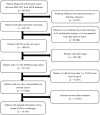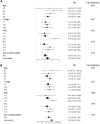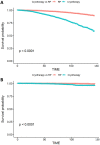Cryotherapy shows no inferiority compared with radical Prostatectomy for low-risk and intermediate-risk localized Prostate Cancer: a real-world study from the SEER database
- PMID: 32913467
- PMCID: PMC7477459
- DOI: 10.7150/jca.38323
Cryotherapy shows no inferiority compared with radical Prostatectomy for low-risk and intermediate-risk localized Prostate Cancer: a real-world study from the SEER database
Abstract
Background: For localized prostate cancer (PCa) with a low disease burden, whole-gland resection seems like overtreatment, while focal therapy, including cryosurgery, can achieve similar outcomes. We aimed at comparing the long-term survival outcomes of cryotherapy and radical prostatectomy (RP) and further exploring whether RP can be replaced by cryosurgery for those with low-risk PCa. Methods: We conducted analyses from the Surveillance, Epidemiology, and End Results (SEER) database (2004-2015) and performed propensity score matching and used an instrumental variate to reduce the influence of bias and unmeasured confounders to the greatest extent. Results: In the multivariate regression, patients who received cryotherapy had higher risk of overall mortality (OM) (hazard ratio [HR] = 2.52, 95% confidence interval [CI] 1.99-3.20, p < 0.001), but no significant difference was observed in decreasing cancer-specific mortality (CSM) (HR = 1.38, 95% CI 0.63-3.03, p = 0.41) after adjusting the confounders. After propensity score matching, patients who underwent cryotherapy had higher OM and CSM rates (HR = 2.70 [95% CI 1.99-3.66, p < 0.001] and HR = 2.99 [95% CI 1.19-7.48, p = 0.02], respectively). In the IV-adjusted analyses, RP was superior to cryotherapy in decreasing OM (HR = 2.52, 95% CI 1.99-3.20), while no obvious decrease of CSM was observed in the comparison of RP and cryotherapy (HR = 1.38, 95% CI 0.63-3.03). The subgroup analyses showed that RP displayed an obvious benefit in decreasing CSM (HR = 5.02, 95% CI 1.30-19.39, p = 0.02) for those with a prostate-specific antigen (PSA) level higher than 10 ng/ml. Conclusion: RP ranked as the best treatment in regard to tumor control, but the advantages of cryotherapy became evident when taking functional and oncological outcomes into account, especially for low- and intermediate-risk PCa with low PSA levels.
Keywords: Cryotherapy; Localized; Prostate Cancer; Radical Prostatectomy.
© The author(s).
Conflict of interest statement
Competing Interests: The authors have declared that no competing interest exists.
Figures



References
-
- Siegel RL, Miller KD, Jemal A. Cancer statistics, 2017. CA Cancer J Clin. 2017;67:7–30. - PubMed
-
- Ferlay J, Soerjomataram I, Dikshit R. et al. Cancer incidence and mortality worldwide: sources, methods and major patterns in GLOBOCAN 2012. Int J Cancer. 2015;136:E359–86. - PubMed
-
- Heidenreich A, Bellmunt J, Bolla M. et al. EAU guidelines on prostate cancer. Part 1: screening, diagnosis, and treatment of clinically localised disease. Eur Urol. 2011;59:61–71. - PubMed
-
- Menon M, Dalela D, Jamil M. et al. Functional recovery, oncologic outcomes and postoperative complications 12 months following robot-assisted radical prostatectomy: follow-up of an evidence-based analysis comparing the Retzius sparing and standard approaches. J Urol. 2018;199:1210–7. - PubMed
-
- Hamdy FC, Donovan JL, Lane JA. et al. 10-Year outcomes after monitoring, surgery, or radiotherapy for localized prostate cancer. New Engl J Med. 2016;375:1415–24. - PubMed
LinkOut - more resources
Full Text Sources
Research Materials
Miscellaneous

